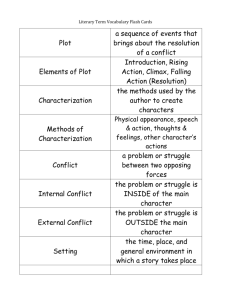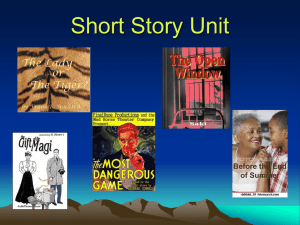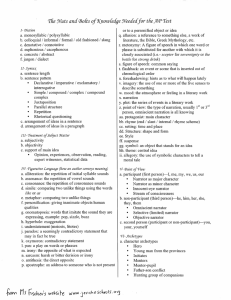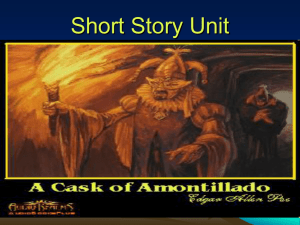NUTS AND BOLTS
advertisement
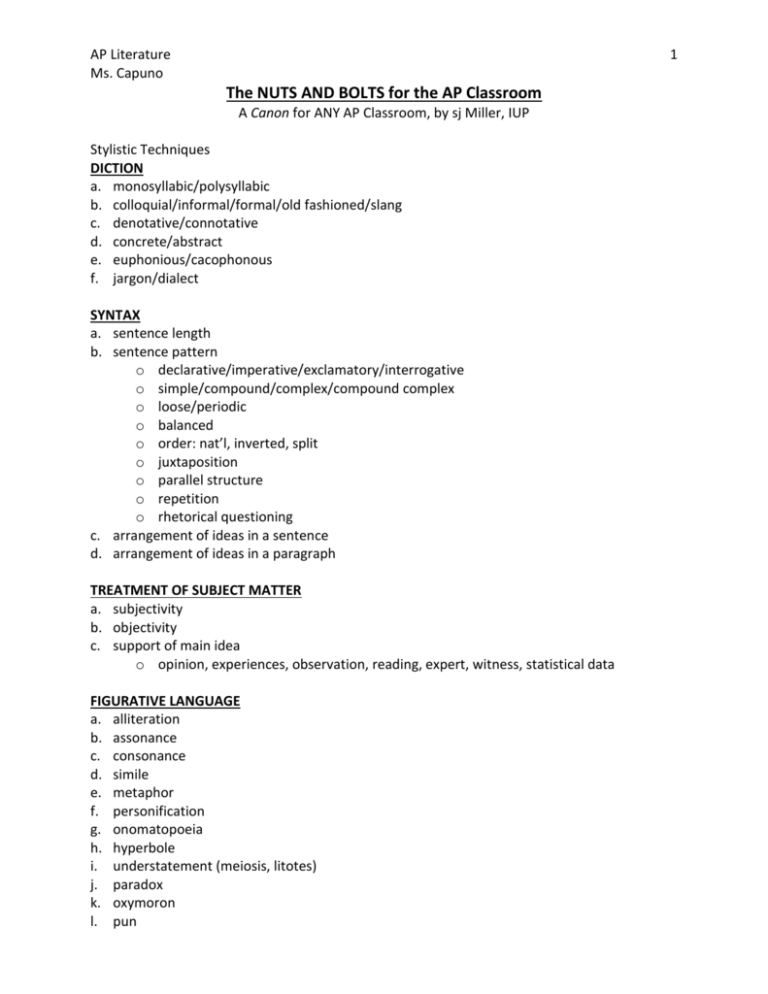
AP Literature Ms. Capuno 1 The NUTS AND BOLTS for the AP Classroom A Canon for ANY AP Classroom, by sj Miller, IUP Stylistic Techniques DICTION a. monosyllabic/polysyllabic b. colloquial/informal/formal/old fashioned/slang c. denotative/connotative d. concrete/abstract e. euphonious/cacophonous f. jargon/dialect SYNTAX a. sentence length b. sentence pattern o declarative/imperative/exclamatory/interrogative o simple/compound/complex/compound complex o loose/periodic o balanced o order: nat’l, inverted, split o juxtaposition o parallel structure o repetition o rhetorical questioning c. arrangement of ideas in a sentence d. arrangement of ideas in a paragraph TREATMENT OF SUBJECT MATTER a. subjectivity b. objectivity c. support of main idea o opinion, experiences, observation, reading, expert, witness, statistical data FIGURATIVE LANGUAGE a. alliteration b. assonance c. consonance d. simile e. metaphor f. personification g. onomatopoeia h. hyperbole i. understatement (meiosis, litotes) j. paradox k. oxymoron l. pun AP Literature Ms. Capuno m. irony n. sarcasm o. antithesis p. apostrophe q. allusion r. synecdoche s. metonymy t. details u. figures of speech v. flashback w. foreshadowing x. imagery y. mood z. motivation aa. narration bb. plot cc. point of view dd. prosody ee. protagonist ff. rhyme (end/slant/internal/rhyme scheme) gg. setting hh. shift or turn ii. sound devices jj. structure kk. style ll. suspense mm. symbol nn. theme oo. understatement pp. allegory POINT OF VIEW a. first person (participant) o I, me, my, we, us, our o Narrator as major character o Narrator as minor character o Innocent-eye narrator o Stream of consciousness b. third person (nonparticipant) o He, him, her, she, they, them o Omniscient narrator o Selective (limited) narrator o Objective narrator c. second person (participant or nonparticipant) o you, your, yourself 2 AP Literature Ms. Capuno ARCHETYPES Character: hero young man from the provinces initiates mentors mentor-pupil father-son conflict hunting group of companions loyal retainers friendly beast civil figure with good heart scapegoat outcast devil figure creature of nightmare woman figure o earth mother o temptress o platonic ideal o unfaithful wife o damsel in distress Symbolic: light vs. darkness water vs. desert heaven vs. hell innate wisdom vs. educated stupidity haven vs. wilderness supernatural intervention magic weapon Situational: quest-journey task initiation journey-search for truth fall death and resurrection nature vs. mechanistic world battle between good and evil unhealable wound ritual ALLUSION a. personal b. biblical 3 AP Literature Ms. Capuno c. mythological d. historical e. literary to literary IMAGERY mythological biblical historical colors nature animals positions buildings names vehicles pictures books/magazines films/TV/video CHARACTERIZATION what or where characters…say, do, think, have, wear, are; with whom they associate, what others say about them ANALYZING TRAGEDY and TRAGIC FICTION Aristotelian Theory: unity of action catharsis tragedy (hamartia/hubris) o peripeteia o anagnorisis scene of suffering COMEDIC LADDER Comedy of ideas o Characters argue about ideas like politics, religion, sex, marriage o Use their wit, clever language to mock their opponent in an argument o Subtle way to satirize people and institutions like political parties, governments, churches, war, marriage Comedy of manners o Amorous intrigues among the upper classes o Focus is on witty language, clever speech; insults and putdowns are traded between characters 4 AP Literature Ms. Capuno o Society is often made up of cliques that are exclusive with certain groups as the incrowd, other groups, the would-be-wits, desiring to be part of the witty crowd, and some, the witness on the outside Farce o Plot is full of coincidences, mistiming, mistaken identities o Characters are puppets of fate—they are twins, born to the wrong class, unable to marry, too poor, too rich… o Loss of identity because of birth or fate or accident o Sometimes they are twins separated unaware of their double Low Comedy o Dirty jokes, dirty gestures, sex, and elimination o Exaggeration or understatement are the extremes of humor with a focus on the physical, i.e. long noses, cross eyes, humped back, and deformities o Slapstick, pratfalls, loud noises, physical mishaps, collisions Comedy is based on irony awareness of irony is an intellectual, not emotional process lifts us out of emotional responses makes us laugh can make us feel superior to characters can sense our own rigidity, which arouses laughter THEMES thematic statement = elevated diction + comment on the book abuse/neglect/battered women’s syndrome alienation/loneliness ambition appearance vs. reality betrayal bureaucracy children courage/cowardice chance/fate/luck cruelty/violence custom/tradition defeat/failure despair/discontent/disillusionment dreams/fantasies domination/suppression duty/allegiance/blind faith escape/confinement ethics vs. morality/right vs. wrong exile/persecution falsity/pretense/affectation family/parenthood/deconstructed family 5 AP Literature Ms. Capuno 6 gender evolution the “ISMS” (prejudices: racism, sexism, classism, sizism, ageism, lookism, hetereosexism, ablebodied ism, anti-Semitism…) freewill/will power games/sports greed guilt heaven/paradise/utopia home heart vs. reason initiation illusion/innocence instinct journey law/justice/revenge education/school materialism memory/past mob psychology music/dance mysterious stranger nature vs. mechanistic world persistence/perseverance patriotism poverty/class prophecy redemption/salvation repentance resistance/rebellion revenge/retribution ritual/ceremony scapegoat/victim/suicide media search for self teen pregnancy time war TONE (feeling/mood/attitude/emotion/effect) lighthearted confident amused complementary hopeful cherry elated passionate exuberant optimistic AP Literature Ms. Capuno sympathetic proud enthusiastic loving compassionate indignant foreboding reverent irreverent diffident contemptuous angry furious irritated accusing disgusted condemnatory outraged bitter threatening inflammatory disdainful formal ceremonial restrained detached objective informative candid clinical objective questioning instructive matter-of-fact admonitory learned factual didactic authoritative incredulous shocked baffled disbelieving urgent nostalgic 7 reminiscent sentimental whimsical fanciful scornful sarcastic critical satiric bantering taunting ironic amused patronizing pompous disdainful cynical facetious sardonic insolent flippant contemptuous condescending mock-heroic whimsical melancholic mournful apprehensive despairing resigned elegiac sentimental pedantic disturbed serious fearful sober staid somber sad solemn concerned gloomy hopeless AP Literature Ms. Capuno 8 TP-CASTT A Way to Identify and Unpack Literary/Poetic Devices T-TITLE: ponder the title before reading the poem, work P-PARAPHRASE: translate the work/poem for meaning beyond the literal and into your own words C-CONNOTATION: contemplate the work for meaning beyond the literal A-ATTITUDE: observe both the speaker’s and author’s attitude (tone) S-SHIFTS: note shifts in speaker’s and author’s attitude TITLE: examine the title again—this time on an interpretive level THEME: determine what the author is staying DIDLS A way to understand a work through the examination of the author’s tone or attitude towards the subject D-DICTION: the connotation of word choice I-IMAGES: vivid appeals to understanding through the senses D-DETAILS: facts included or omitted L-LANGUAGE: overall use of language such as formal, jargon, clinical… S-SENTENCE STRUCTURE: how structure affects the reader’s attitude



